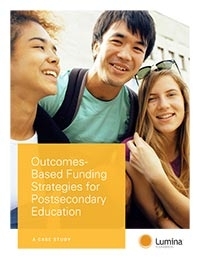
States trying to raise the number of people with education and training after high school should focus on those who’ve been poorly served in the past, new reports show. We know that promoting racial and economic justice is the right thing to do—now it turns out to be good public policy, too.
That’s some of the advice given in the Equity Policy Academy sponsored by Lumina Foundation and the University of Southern California Center for Urban Education. Lumina has published a report on the training seminar, along with two other case studies about the need for statewide educational attainment goals and funding student outcomes.
The new report on the academy shows how it helped leaders and policymakers build the skills to take a different approach to their states’ systems of education and training after high school.
The approach centers on equity, a system in which different populations—African American, Hispanic, and American Indian—are supported to reach the same successful outcomes, not just given the same opportunities to succeed.
The academy helped Michigan, Minnesota, Ohio, Vermont, and Virginia use leadership, policy, and budget changes to focus on equity, starting with state education and workforce goals. If successful, this will lead to the dramatic shift that states call for: an increase in numbers of residents earning postsecondary credentials and making family-sustaining wages far and above what the status quo would create.
Our report on the academy includes these skills-building areas and points of advice:
- Know your state—Investigate the demographic and economic situation, identify populations that aren’t being served well, and assess how differences in educational outcomes by race and ethnicity limit the economic prospects of the state and its residents.
- Build a careful process—Get a buy-in from a range of stakeholders—sometimes the process is just as important as the goal it strives to achieve.
- Craft a strong message—Conveying a sense of urgency—which is justified, given the shortage of skilled workers in the country—helps create buy-in from a wide range of potential supporters.
- Know what works—Identify existing organizations, policies, and programs that can help in the effort to close attainment gaps.
- Make the plan a living document—Populations and economic needs change over time. States must update their plans regularly and keep community leaders and the public informed of the progress.
With this foundation, states can identify the best leadership, budget, and policy changes. Our two other reports explore changes that can help states dramatically increase the number of residents earning high-quality certifications, certificates, and degrees, by setting statewide educational attainment goals and funding student outcomes.
While there is no one-size-fits-all approach, there are shared insights across the diverse set of states chronicled in the reports—including Arizona, New Hampshire, Tennessee, and Indiana.
In its state policy agenda for 2017-20, Lumina outlines ways that states can increase attainment, especially among people who have not been set up to succeed in the past.
As the new case studies show, Lumina continues to learn from these states working on equity-minded policymaking, setting state goals, and funding student outcomes. The new reports are a tool for the public to share in that learning, too.
Gretchen Syverud is a strategy officer for Lumina Foundation who supports state efforts to increase postsecondary attainment through the foundation’s state policy agenda.

 Equity Policy Academy
Equity Policy Academy Outcomes-Based Funding Strategies for Postsecondary Education
Outcomes-Based Funding Strategies for Postsecondary Education Statewide Educational Attainment Goals
Statewide Educational Attainment Goals